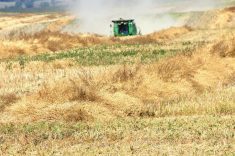Speckle Park cattle have taken Australia by storm since Greg Ebbeck first showed the breed in his home country three years ago.
The breed has soared in popularity, outstripping the competition in live and carcass contests.
At Canadian Western Agribition in Regina last week, Ebbeck bought a package of six embryos for his Australian operation in Meadow Flat, New South Wales.
“Australia hasn’t seen the demand for a product ever like it has for Speckle Park,” the long-time Hereford breeder said.
Read Also

Alberta researcher helps unlock the economics of farming
Lethbridge Polytechnic researcher helping agriculture producers with decision-making tools in economic feasibility
“The best restaurants in the country can’t get enough of it.”
The breed also has an exclusive supply contract with Emirates Airlines, which has replaced Angus on the first-class menu.
Ebbeck said the amount of money that has been spent developing the carcass and meat side of the breed has been “mind blowing.”
An Agribition attendee for 28 of the 41 shows, he first saw Speckle Park when they debuted at the show after being officially declared a breed in 2006. He used to take home Hereford genetics, but the last six years he has focused on Speckle Park.
“It’s their carcass attributes and meat quality, tenderness and taste.”
The embryos he has imported have resulted in an Australian herd of 2,500 head, rivaling the number in Canada, where the breed was developed.
There are now 56 members in Speckle Park Inc., an international organization based at the University of Armidale in New South Wales.
The association has a patented and trademarked branded beef product called Speckle Park Supreme.
“For that they have to be 50 percent Speckle Park and out of any recognized British breed,” Ebbeck said.
Crosses with Brahman cattle are becoming popular in parts of Australia, and demand for bulls is strong.
“They have a lot of hybrid vigour,” he said. “They are quite a bit bigger than Brangus and Brereford, and thicker.”
He doesn’t see demand for Speckle Park genetics or meat dropping soon.
A Speckle Park female topped the 36-breed show at the Melbourne Royal agricultural show in just a third appearance. At the Sydney Royal, which is the largest show in the southern hemisphere, Speckle Park finished in the top five.
The breed gets more respect in Australia than Canada, said Ebbeck, who has ranches in both countries under the Six Star name. He owns the former Star Buck operation at Neilburg, Sask. Many still favour black hides in North America.
“In Australia, the colour pattern was a plus,” he said. “Buyers knew exactly what they were getting.”
The cattle seem to do as well at 40 C as they do at -40 C, he said, adding the toughness comes from their Angus and British breed ancestors.
Ebbeck has 80 purebred cows and 40 to 50 that he uses for embryo transplant.
“Considering it’s a small breed in terms of numbers, the genetic base is quite diverse,” he said.
Agribition show results
•JSF Black Magic 3Y was the grand champion female. It was exhibited by Jason Goodfellow, who operates Six Star at Neilburg, Sask., with co-owners Johner Stock Farm, Silver Tip Speckle Park and Morrison Land and Livestock
•Reserve was Notta 68L Uptown Girl 16U from Redneck Ranch of Odessa, Sask.
•Grand champion bull was River Hill 26T Walker 60W from River Hill Farm at Neilburg
•Reserve was Spots ‘n Sprouts Stands Alone, shown by Goodfellow
•The sale saw 20 lots average $2,777.50
•The high seller was a $6,000 bred heifer from Legacy Speckle Park at Theodore, Sask., which went to Alex Steel and Andchris Farms at Ingersoll, Ont.















